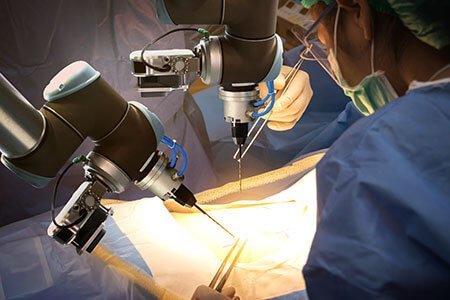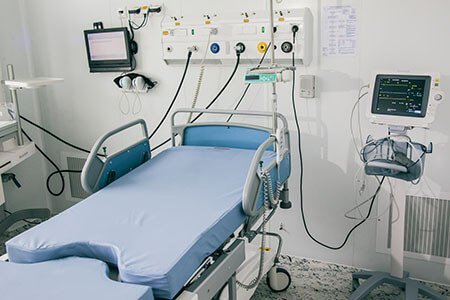Robot-Assisted Gynecological Surgeries
Robot-assisted hysterectomy, its benefits, risks, success rates and costs
Things you need to know about Robot-Assisted Gynecological Surgeries
What are different robot-assisted gynaecologic surgeries such as hysterectomy? When are they recommended?
For years, open surgery, which uses large incision for accessing uterus and surrounding anatomy, has been the standard approach to gynecologic surgeries.
Open surgery is an invasive procedure associated with significant pain, trauma, a long recovery process and damage to surrounding organs and nerves.
With the advent of new technologies, lesser invasive options like laparoscopy are now available. However, with monitors that have a two-dimensional (2D) vision, laparoscopic procedures have disadvantages like lesser in-depth perception, camera instability, limited range of motion. Thus, laparoscopy has its own challenges for delicate and complex surgeries like hysterectomies (removal of the uterus) or endometriosis.

Robot Assisted Gynecological Surgery
For delicate surgical procedures, the robot-assisted surgery is considered to be the most effective treatment option available today. By making few tiny 1-2 cm incisions, the surgeon operates with greater precision and control. Since the risk associated with large incision is greatly reduced, there is a greater likelihood of a fast recovery and excellent clinical outcomes. Robotic surgery can be performed for various gynecological conditions like:
- Hysterectomy (benign or cancerous) i.e. removal of the uterus
- Myomectomy: for the removal of fibroids from the uterus
- Sacrocolpopexy: surgical correction of vaginal vault prolapses
- Surgery for gynecological cancer
- Oophorectomy and ovarian cystectomy: removal of ovary an ovarian cyst
- Resection of endometriosis
- Lymphadenectomy
- Other surgeries: cervical cerclage, vesicovaginal repair, rectovaginopexy and Burch colposuspension
The robotic surgical system comprises of three components:
- A surgeon’s console
- A patient-side cart with four robotic arms
- A high-definition, magnified (12X), and a 3D vision system
The movements of the surgeon’s hand are mimicked by the instruments attached to the robotic arms, which are smaller in size, and more flexible than the human hand.
What is robot- assisted surgery?
Robot-assisted surgery is an advancement in surgical technology using which, with minimal invasion, surgeons can perform complex surgeries with high precision and control resulting in improved patient outcomes. The surgical robotic systems use a high definition magnified 3D vision and a computer-controlled robotic arm and small tools attached to it.
What are the technical advantages of robot-assisted gynecologic surgery over conventional gynecologic surgery?
Some of the technical advantages of the robotic surgery are:
- The endo-wrist movements of a robotic instrument are free from tremors and enable the surgeon to perform the most complex procedures with enhanced precision, dexterity, and control.
- It provides ambidexterity and is free from the fulcrum effect associated with endoscopic instruments.
- The improved three-dimensional magnified vision of the surgical site allows a better view for the surgeon.
- With the help of robotic approach, surgeons can remove as many myomas of varying sizes. This also helps to remove myomas and suture the uterine defect in odd locations.
- Intracapsular myomectomy via robotic approach preserves the nerves surrounding fibroids. This helps in better healing of myometrium, minimal adhesion and good postoperative healing.
What are the advantages of robot-assisted gynecologic surgery over open gynecologic surgery in terms of patient outcomes?
The robot-assisted surgery is performed using keyhole incisions, therefore it offers the advantages of:
- Lesser destruction of surrounding tissue and trauma
- Faster healing
- Lesser loss of blood
- Less postoperative pain
- Shorter recovery time
- Lesser risk of infection
- Smaller incisions lead to lesser scarring
- Quicker return to normal activity and work
What are the risks involved in robot-assisted gynecologic surgeries?
As with any surgery, there is some degree of risks involved with robot-assisted surgery. However, the risk involved is minuscule. The benefits of robot-assisted surgery outweigh the risks involved, thus robotic-assisted surgery is preferred over open surgery nowadays. The benefits associated with robotic gynecologic surgeries are:
- Reduced risk of post-surgical infection
- Rare life-threatening risks such as stroke, bleeding and infections
- Lesser chances of damage to nearby organs in pelvic and abdominal cavity
- Lower in-hospital mortality rates
- Faster recovery time and return to normal activities
- Smaller incisions, resulting in reduced risk of infection
- Reduced complications related to anesthesia
What are the success rates of robot-assisted gynecologic surgery?
The success rate of gynecological surgeries is highly dependent on the patient’s characteristics like age and overall health, the severity of disease etc. However one of the main benefits of robotic surgery is that it has fewer risks than open-surgery, thus contributing to a higher rate of success. Studies have shown that robot-assisted gynecological surgeries are associated with
- Better treatment outcomes, especially in obese patients or complicated surgeries
- Better improvement in sexual function and improvement of pelvic support
- Improved symptomatic relief
- Restoredfertility
What factors should be considered while choosing a hospital for robot-assisted gynecologic surgery?
For the best possible outcomes of the surgery, one should consider a hospital that has a team of specialists experienced in performing successful gynecological surgery and have good training and expertise in robotic surgery.
For successful and safe gynecological surgery experience, consider the following factors:
- State-of-the-art robotic surgery technology and robotic systems.
- A healthcare center with advanced surgical facilities and healthcare team led by qualified and experienced MIGS surgeon (Minimal Invasive Gynecologic Surgery).
- The expertise of the team in robotic surgery. Specialized training in robotics, the number of surgeries performed and success rate indicate the expertise of the surgeon.
- Availability of the necessary infrastructure like diagnostics, pharmacy, OT, and ICUs to support the pre-operative and post-operative needs is as important as a well-trained team.
What factors govern the cost of robot-assisted gynecologic surgery?
The cost of surgery usually depends on various factors like:
- Experience and expertise of the MIGS surgeon and his team
- Surgery facilities and equipment
- Length of surgery and post-surgical complications
- Hospital Stays
- Diagnostic tests andmedicines
- Underlying co-morbidities and age of the patient which may affect the –number of days in the hospital, requirement of additional tests, medication etc

Cost of robot-assisted gynecologic surgery
To know more about robot-assisted hysterectomy, you can request a callback and our robotic surgery specialist will call you and answer all your queries.
References:
- Sinha R, Sanjay M, Rupa B, et al. Robotic surgery in gynecology. J Minim Access Surg. 2015 Jan-Mar; 11(1): 50–59.
- Joliniere JBD, Librino A, Dubuisson IJB, et al. Robotic Surgery in Gynecology. Front Surg. 2016; 3: 26.
Disclaimer:
“The content of this publication has been developed by a third party content providerwho are clinicians and/or medical writers and/or experts. The information contained herein is for educational purpose only and we request you to please consult a Registered Medical Practitioner or Doctor before deciding the appropriate diagnosis and treatment plan.”



 Appointment
Appointment Second Opinion
Second Opinion WhatsApp
WhatsApp Call
Call More
More





